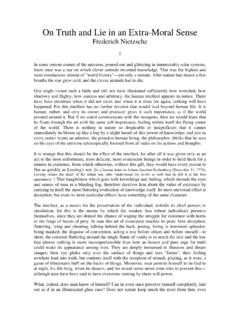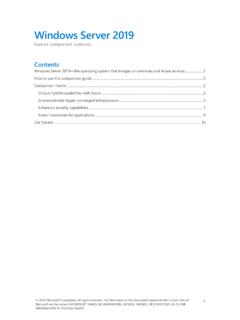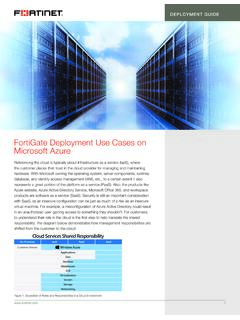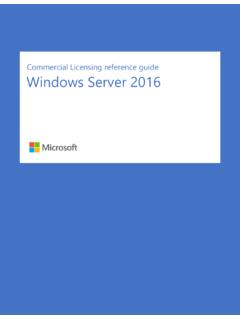Transcription of Introduction to Cloud Computing - KTH
1 ID2210 Jim DowlingIntroduction to Cloud ComputingCloud Computing Cloud computingis the delivery of hosting services that are provided to a client over the large-scale services without up-front S LAUNCHINGVM LAUNCHING![XKCD Comic 303]Clouds are Elastic NIST Definition of Cloud Computing " Cloud Computing is a model for enabling convenient, on-demand network access to a shared pool of configurable Computing resources ( , networks, servers, storage , applications, and services) that can be rapidly provisioned and released with minimal management effort or service provider interaction."Supporting Technologies Enormous computer data-centres containing commodity hardware. Virtualizationof computation, storage , and hardware and networking into software!
2 Achieve economies of costs of electricity, bandwidth, hardware, software and use low-cost than provisioning own hardware. Large-scale distributed systems services, such as NoSQLdatastores, object stores, and distributed filesystems, have enabled developers to build scalable Cloud Computing Computing Essentials Cloud Computing is Utility Computing - Cloud servicesare controlled and monitored by the Cloud provider through a pay-per-use business model. An ideal Cloud Computing platform is:-efficient in its use of resources-scalable -elastic -self-managing - highly available and accessible-inter-operable and portableCloud Properties Resource efficiency: Computing and network resources are pooled to provide services to multiple users.
3 Resource allocation is dynamically adapted according to user demand. Elasticity: Computing resources can be rapidly and elastically provisioned to scale up, and released to scale down based on consumer s demand. Cloud Properties Self-managing services:a consumer can provision Cloud services, such as web applications, server time, processing, storage and network as needed and automatically without requiring human interaction with each service s provider Accessible and highly available : cloudresources are available over the network anytime and anywhere and are accessed through standard mechanisms that promote use by different types of platform ( , mobile phones, laptops, and PDAs).Over or Under-ProvisioningShaded area is unused area representsrequests not served.
4 Less and less Provisioning In traditional Computing model, two common problems :-Underestimate system utilization which result in under provisionResourcesDemandCapacity123 ResourcesDemandCapacity123 ResourcesDemandCapacityTime (days)123 Loss UsersLoss RevenueDynamic Provisioning Overestimate system utilization which results in low utilization How do we solve this problem?-Dynamically provision resourcesUnused resourcesDemandCapacityTimeResourcesReal world estimates Average server utilization is 5% to 20%. Peak workload exceeds the average by factors of 2 to 10. Users provision for the peak. Peak loads may occur based on the time of day or based on other factors ( photo sharing after the holidays, drop/add within two weeks of start of term, etc.)
5 Public Clouds, Private CloudsDeployment Model There are four primary Cloud deployment models :-Public Cloud -Private Cloud -Community Cloud -Hybrid CloudPublic Clouds Public clouds are owned by Cloud service providers who charge for the use of Cloud resources. Basic characteristics:-Homogeneous infrastructure, Common policies-Shared resources and multi-tenancy-Leased or rented infrastructure-Economies of scale AWS/EC2(Amazon) Azure(Microsoft) Google Cloud Platform. Clouds The Cloud infrastructure belongs to and is operated by only one organization. Basic characteristics :-Heterogeneous infrastructure; Customized policies-Dedicated resources-In-house infrastructure; End-to-end control Examples include:Other types of Clouds Community Cloud -The Cloud infrastructure is shared by several organizations and supports a specific community that has shared concerns ( , mission, security requirements, policy, and compliance considerations).
6 Hybrid Cloud -The Cloud infrastructure is a composition of two or more clouds (private, community, or public) that remain unique entities but are bound together by standardized or proprietary technology that enables data and application , PaaS and SaaS Infrastructure as a Service (IaaS) Platform as a Service (PaaS) Software as a Service (SaaS)InfrastructureServers storage NetworkIaaSPlatformOS & Application StackInfrastructureServers storage NetworkPaaSApplicationsPackaged SoftwarePlatformOS & Application StackInfrastructureServers storage NetworkSaaSSpectrum of Cloud UsersImage credit: Virtualizationis the abstraction of logical resources away from underlying physical resources. A hypervisor (or Virtual Machine Monitor (VMM)) virtualizes a platform s operating hypervisor manages OS as virtual machines (VMs), enabling multiple OS to share the same physical s Trap and Emulate Model The hypervisor s virtualization paradigm is trap and emulate:-Normal instructions of guest OS run directly on processor in user Calls CPU will trap to interrupt handler vector of Hypervisor.
7 Hypervisor jump back into guest Interrupts Hardware makes CPU trap to interrupt handler of Hypervisor. Hypervisor jumps to corresponding interrupt handler of guest Instructions Running privilege instructions in guest OS will be trapped to Hypervisor for instruction emulation. After emulation, the Hypervisor jumps back to guest and Emulate Model (VMM=Hypervisor)VM Context Switching The hypervisor context switches virtual Interrupt in running switch to saves state of running determines next VM to sets timer restores state of next sets the program counter to timer interrupt handler of next VM Context SwitchingHypervisor Models[ ]KVM (Kernel-based Virtual Machine) VMWareand Xenare the best-known virtualization platforms.
8 KVM (Kernel-based Virtual Machine) is an open-source virtualization platform-Linux host OS-Run multiple virtual machines (Windows, MAC, etc) on your linuxbox-IO is virtualized using a device model in KVM-KVM requires a modified QEMU (open-source processor emulator) for its IO virtualization 1 Hypervisor, as it is a kernel-level using KVM in Linux KVM is a loadable kernel provides the core virtualization processor specific modulesVirtual Machines are software APIs to drive REST API Features Authentication Servers-List Servers IPs-Create Server-Delete Server-Reboot Server Flavors (hardware config)-List Flavors-Get Flavor Details Images-List Images-Create Image/Snapshot-Get Image Details-Delete Image Backup Schedules-List Backup Schedules-Create/Update-DisablePlatform- as-a-Service (PaaS)IaaSis not Enough IaaSprovides virtual machines, but it cannot provide elastic computingby itself, where services scale up and down to meet user provisioning Existing IaaS do not provide support for the sharing middleware platforms among different VMs-Multi-tenancyMulti-tenancy Multi-tenancy is where a single instance of the software runs on a server, serving multiple multiple users in a MySQL database-Java 9 should support multi-tenancy (many java programs running in the same JVM)
9 The software should be able to provide a single service to all customers by setting configurations-More efficient use of server resourcesAMIsIaaS-what you getUbuntuCentOSWindowsRedhatInfrastructu re-as-a-ServiceAMIsPre-BakedAMIsYou might prefer Platform-as-a-ServiceHDFSYARNC onfigured stack of servers, dependencies, and firewalls and your app on lots of CenterPlatform-as-a-Service (PaaS) Platform as a Service (PaaS)is a Computing platform that abstracts the infrastructure, OS, and middleware to drive developer productivity. PaaS leverages dynamic provisioning PaaS leverages multi-tenancyClosed PaaS A closed PaaSprovides a fixed set of services you can use. You cannot install your own services. They are typically hosted at some Langs/ServicesHerokuRuby, , JVM-langs, Python, SQL-DB, KV-StoreAppFogPHP,Ruby, , Python, SQL-DB, KV-StoreAppEngine(Google)Python, JVM-langs, GoLangAWS Beanstalk, RightScale, EngineYard, CloudBees.
10 Open PaaS An open PaaSprovides support for you to develop your own automated service Installation: Chef/Puppet/Salt/AnsibleAgentAgentAgentM asterRecipesRecipesRecipesKaramel/Chef Cluster definition in YAML Virtualization using JClouds-Support for AWS/EC2, Google Cloud Platform, OpenStack Karamelfileto Orchestrate Chef Recipes Chef-solo to execute recipes Standalone thick-client application-Ability to store user credentials-Ability to use discover the user s own sshkeysKaramelKaramel/ChefSSHSSHSSHJC loudsAPIGitHubAPIGitHubAWC-EC2 ValidateChef CookbooksCreate VMsChef Cookbooks cloned from GitHubChef-Solo installs software no Chef Study: Installing HadoopCloudera Manager Cloud Express Wizard*Go to EC2 in AWS web console and select Instances Use the default N.














